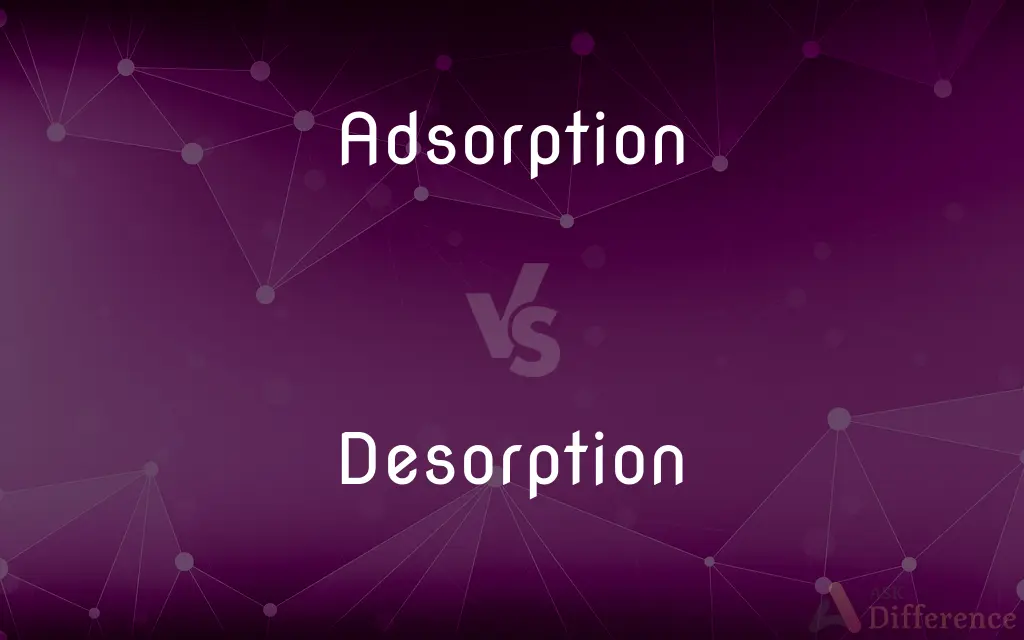Adsorption vs. Desorption — What's the Difference?
Edited by Tayyaba Rehman — By Fiza Rafique — Updated on March 19, 2024
Adsorption is the process of molecules adhering to a surface, whereas desorption is the release of molecules from a surface.

Difference Between Adsorption and Desorption
Table of Contents
ADVERTISEMENT
Key Differences
Adsorption and desorption are complementary processes involved in the interaction of molecules with a surface. Desorption, on the other hand, is the process by which adsorbed molecules are released from a previously adsorbed surface. It effectively reverses the adsorption process, and can occur naturally or be induced by external factors like temperature increase or pressure decrease.
Adsorption is crucial in various applications, including filtration, in creating adsorbents like activated charcoal that trap contaminants. Desorption plays a key role in processes such as chromatography, where it is necessary for the recovery and analysis of adsorbed substances.
The rate and extent of adsorption can depend on factors such as the nature of the adsorbate and adsorbent, temperature, and pressure. Adsorption can be either exothermic or endothermic, though it is most commonly exothermic, as the adsorption process typically releases energy. Desorption, conversely, might require an input of energy to overcome the forces holding the adsorbate to the adsorbent's surface. This energy can be supplied in various forms, including heat, changes in pressure, or chemical reactions.
Adsorption is often described using isotherms, which are curves that relate the amount of adsorbate on the adsorbent surface to its concentration in the bulk phase at constant temperature. Desorption curves, while less commonly discussed in basic science, are essential for understanding the efficiency of regeneration of adsorbents or the release of substances from surfaces in practical applications.
In environmental and industrial contexts, adsorption is exploited for water purification, air filtration, and in heterogeneous catalysis, where gases adsorb to the surface of solid catalysts to react more readily. Desorption is utilized in analytical chemistry, pollution control (to regenerate adsorbents), and in controlled release technologies in pharmaceuticals, where drugs are desorbed from carrier matrices at a target site.
ADVERTISEMENT
Comparison Chart
Definition
Process of molecules adhering to a surface.
Process of molecules releasing from a surface.
Nature of Process
Accumulative, can be physical or chemical.
Releasing, often requires energy input.
Role in Processes
Used in filtration, catalysis, and purification.
Important for analysis, recovery, and regeneration.
Energy Change
Typically exothermic (releases energy).
Often endothermic (requires energy).
Factors Influencing
Surface area, pressure, temperature, nature of adsorbate and adsorbent.
Temperature, pressure, chemical changes.
Compare with Definitions
Adsorption
Can be reversible or irreversible depending on the nature of the interaction.
Physisorption is generally reversible, whereas chemisorption is not.
Desorption
Can be induced by increasing temperature or changing pressure.
Thermal desorption was used to regenerate the adsorbent.
Adsorption
The process by which a substance accumulates on the surface of another material.
Adsorption of pollutants onto activated charcoal is a common water purification method.
Desorption
The process by which adsorbed molecules are released from a surface.
Desorption of drugs from carrier matrices is crucial in targeted drug delivery.
Adsorption
Binding of molecules to a surface due to physical or chemical interactions.
The adsorption of gases on metal surfaces is critical in catalysis.
Desorption
Essential for the analysis of adsorbed substances.
Desorption mass spectrometry provides detailed surface composition analysis.
Adsorption
Often characterized by isotherms to describe its efficiency.
The Langmuir isotherm models monolayer adsorption on a homogeneous surface.
Desorption
Used in controlled release technologies.
Desorption rates control the release of fertilizers in smart agriculture systems.
Adsorption
Used in various industrial applications for separation and purification.
Adsorption processes are vital in the production of high-purity gases.
Desorption
Plays a key role in pollution control by regenerating filtering materials.
Desorption processes allow for the reuse of activated carbon in water treatment.
Adsorption
Adsorption is the adhesion of atoms, ions or molecules from a gas, liquid or dissolved solid to a surface. This process creates a film of the adsorbate on the surface of the adsorbent.
Desorption
Desorption is a phenomenon whereby a substance is released from or through a surface. The process is the opposite of sorption (that is, either adsorption or absorption).
Adsorption
The accumulation of gases, liquids, or solutes on the surface of a solid or liquid.
Desorption
The release of an adsorbed substance from a surface
Cholesterol desorption from cell membranes
Adsorption
The adhesion of a liquid or gas on the surface of a solid material, forming a thin film on the surface.
Desorption
To release (something) through pores or interstices.
Adsorption
The process by which molecules of a substance form a thin film on the surface of a solid. Distinguished from absorption, in which the foreign substance penetrates the body of the absorbing material.
Desorption
To remove (an absorbed or adsorbed substance) from.
Adsorption
The accumulation of molecules of a gas to form a thin film on the surface of a solid
Desorption
The process in which atomic or molecular species leave the surface of a solid and escape into the surroundings; the reverse of absorption or adsorption.
Desorption
Changing from an adsorbed state on a surface to a gaseous or liquid state
Common Curiosities
What is the difference between physisorption and chemisorption?
Physisorption involves weak van der Waals forces, is usually reversible, and low energy, whereas chemisorption involves stronger chemical bonds, is often irreversible, and high energy.
Why is adsorption exothermic?
Adsorption is exothermic because it involves the release of energy as molecules settle into a lower energy state on the adsorbent surface.
Can desorption be spontaneous?
Desorption can be spontaneous if the conditions favor the dissociation of molecules from the surface, often requiring an external energy input.
Why is desorption important in analytical chemistry?
Desorption allows scientists to release and analyze molecules from surfaces, crucial for understanding chemical compositions and reactions.
Are adsorption and desorption reversible processes?
They can be, depending on the nature of the adsorbate-adsorbent interaction and the conditions of the process.
What factors influence the rate of desorption?
The rate of desorption can be influenced by the strength of the adsorbate-adsorbent interaction, temperature, and the presence of competing molecules.
How do temperature and pressure affect adsorption?
Generally, increasing pressure increases adsorption, while increasing temperature decreases adsorption for exothermic processes.
How is adsorption used in pollution control?
Adsorption is used to capture pollutants from air or water on a solid surface, effectively removing them from the environment.
Can all materials act as adsorbents?
Not all materials are effective adsorbents; effective adsorbents typically have high surface area, porosity, and suitable surface chemistry for specific adsorbates.
How do coadsorption and competitive adsorption differ?
Coadsorption involves the simultaneous adsorption of multiple species on the same surface, while competitive adsorption refers to a scenario where multiple species compete for the same adsorption sites.
Share Your Discovery

Previous Comparison
Hypotension vs. Hypertension
Next Comparison
Business vs. CommerceAuthor Spotlight
Written by
Fiza RafiqueFiza Rafique is a skilled content writer at AskDifference.com, where she meticulously refines and enhances written pieces. Drawing from her vast editorial expertise, Fiza ensures clarity, accuracy, and precision in every article. Passionate about language, she continually seeks to elevate the quality of content for readers worldwide.
Edited by
Tayyaba RehmanTayyaba Rehman is a distinguished writer, currently serving as a primary contributor to askdifference.com. As a researcher in semantics and etymology, Tayyaba's passion for the complexity of languages and their distinctions has found a perfect home on the platform. Tayyaba delves into the intricacies of language, distinguishing between commonly confused words and phrases, thereby providing clarity for readers worldwide.
















































